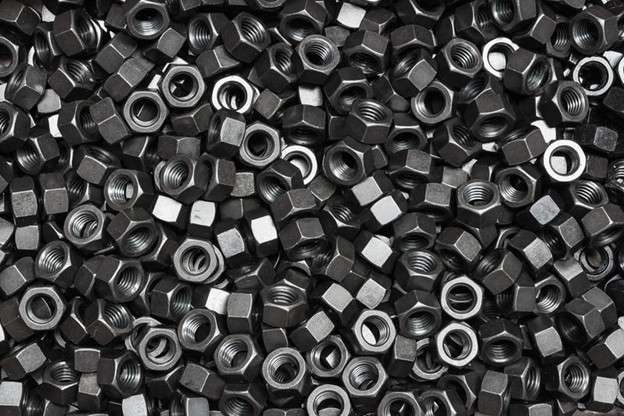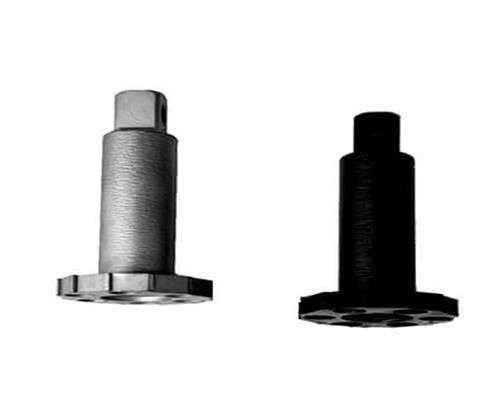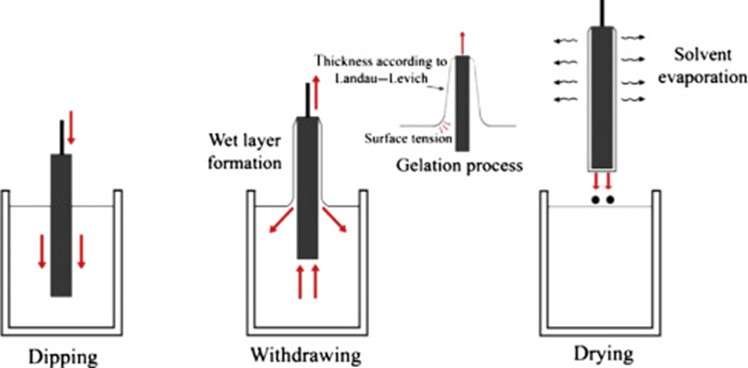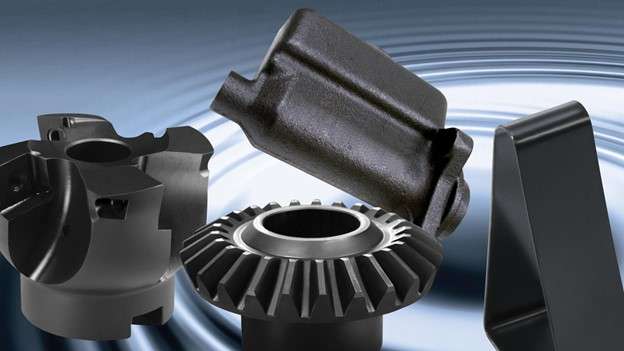
Parts with black-oxide finish
The black oxide finish process uses a chemical conversion coating to create a dark, matte-black finish on metal parts. The resulting finish looks not only great but also provides several benefits. For example, the black-oxide finish increases the part’s corrosion resistance and wear, enhancing its overall aesthetic appearance.
It is a form of surface finishing, which has significant importance in the manufacturing of sustainable parts and products. There are an endless number of surface treatment methods in practice. Manufacturers use those techniques to improve the part’s functionality and visual appeal.
Among several methods is black-oxide finish, which is a well-known surface treatment technique for parts and products made from cast iron, wrought iron, stainless steel, zinc, and other materials.
This article will cover the black oxide finish process, its advantages, applications, and comparison with other surface treatment methods.
What is a Black Oxide Finish?

Black oxide finish
Black oxide is the chemical conversion coating that gives a matte black appearance on the substrate’s surface. It involves a chemical reaction between the substrate and a hot solution that contains different salts and oxidizing agents. The reaction results in a tightly bonded black oxide layer (mostly Fe3O4, called magnetite) on the surface of the metal, which improves its resistance to wear, corrosion, and abrasion.
Black oxide finish is mainly applied to ferrous materials, such as steel, cast iron, and wrought iron. However, it can also be used for other metal parts like zinc, copper, and brass.
ProleanTech has extensive experience with these and many other materials, so your surface treatment requirements are at home with us.
Related Resources:
How Does It Work?
As previously mentioned, the black oxide finish involves a chemical reaction between the metal substrate and the hot solution (135 to 285 0C) of salts and oxidizing agents to form a tightly bonded layer of black oxide on the surface. The black oxide layer typically contains ferrous oxide, magnetite, and hematite, created during the different phases of the reaction.
To understand the in-depth working of black oxide finish, let’s discuss the main chemical reactions that occur while applying it to steel parts. The immersion solution contains a mixture of sodium hydroxide (NaOH), sodium nitrate (NaNO3), and water (H2O).
1. The iron in the steel reacts with the hot solution and forms ferric oxide;
Fe + 2NaOH → Fe (OH) 2 + H2
2Fe (OH) 2 + O2 → 2Fe (OH) 3
4Fe (OH) 3 → 2Fe2O3 + 3H2O
2. Magnetite forms as the black oxide layer grows, Fe (OH) 2 + Fe3O4 → 4FeO·Fe (OH) 2
3. Because of the high temperature, hematite (Fe2O3) is also formed in addition to magnetite.
4FeO·Fe (OH) 2 + O2 → 2Fe2O3·H2O + 2H2O
The Process of Black-Oxide Finish

Black oxide finish process
The process of applying black-oxide finish requires several steps, with the use of appropriate solutions and detailed- procedures. Although the step-by-step process can vary depending on the specific application, the following are the general stages involved in the process:
1. Surface Preparation
The black-oxide finishing process begins with cleaning the surface to prepare it for the coating. It is essential to remove dirt, oil, or other contaminants to ensure that the surface is ready to accept the black oxide solution and can effectively bond with it. This can involve degreasing, washing, (and/or) blasting the parts with abrasive media.
Degreasing is typically done with a solvent-based cleaner or an alkaline degreaser. After degreasing, the metal parts are washed with water to remove any remaining degreaser or other contaminants. Furthermore, some parts might require abrasive blasting to remove the rust, scale, and other surface imperfections that could interfere with the black oxide finish process.
2. The Pre-Treatment Stage
It is a crucial step in the black oxide finish process that ensures the surface is ready to treat with the coating solution. The pre-treatment process typically involves several steps, including cleaning, activation, and conditioning.
Firstly, cleaning the substrate with a hot alkaline solution (such as sodium hydroxide, sodium carbonate, and trisodium phosphate) removes the oxides from the surface. The activation process involves immersing the metal parts in a dilute nitric acid solution. Lastly, conditioning is carried out by immersing the metal parts in a proprietary solution that neutralizes the acid from the activation step.
3. Preparation of Solution
In this stage, the coating solution is prepared by mixing several different chemicals in the correct proportions, depending on the type of substrate metal. The primary components of the black oxide solution are typically sodium hydroxide, sodium nitrite, and water. However, the solution may contain other additives, such as surfactants or wetting agents.
First, the black oxide solution is prepared to dissolve the sodium hydroxide in water to create a concentrated solution, followed by heating the solution at about 130-160 0 C. Then, the sodium nitrite is added slowly, typically in small amounts, while continuously stirring the solution. Finally, the bath solution goes through a slow cooling process, typically around 75-85 0 C.
4. Immersion of Parts
The substrates are immersed in the mixture once heated to a specific temperature (135 to 285 0C) to create the ideal conditions for the black oxide reaction. The immersion time depends on the desired thickness of the black oxide layer, longer time means more thick coating.
After reaching the desired thickness, the parts are removed from the black oxide solution and thoroughly washed with water to eliminate any remaining chemicals.
5. Post-processing
The final step of the black oxide finishing process involves cleaning, drying, and sealing. Firstly, the finished metal parts are rinsed in water to remove any excess solution, followed by treatment with a rust inhibitor. Then the parts are then dried and optionally sealed with a wax or oil coating to protect the black-oxide layer further and enhance its appearance.
What is a Cold Black-Oxide Finish?
The specifics of black-oxide finish application, for instance, temperature, matter. When done under room temperature, the process is tered as ‘cold’. This is not the only distinction of the process, as the table below indicates.
| Property | Description |
|---|---|
| Appearance | Uniform, matte to semi-gloss black finish |
| Corrosion Resistance | Good, especially when combined with a sealant |
| Process Temperature | Room temperature (21-27°C) |
| Substrate Compatibility | Ferrous metals (iron and steel) |
| Thickness | 0.5 to 1 microns (0.00002 to 0.00004 inches) |
| Adhesion | Excellent, as the finish is formed directly on the metal surface |
| Wear Resistance | Moderate, can be improved with proper sealing |
| Impact on Dimensions | Minimal, due to the thin oxide layer |
| Post-treatment | Can be painted, plated, or coated for additional protection |
In contrast to traditional black oxide processes, a cold black-oxide finish is applied at or near room temperature, typically around 21 to 27 0C. It involves using a chemical solution to the metal part, which reacts with the substrate to form a layer of black oxide. The process typically takes only a few minutes and offers many of the same benefits as conventional hot black oxide.
The solutions used in cold black oxide finish are similar to those used in hot black oxide finish. They typically contain sodium hydroxide, sodium nitrite, and other proprietary chemicals. The solution’s composition may differ depending on the specific application and desired outcome.
The cold black oxide finish could be better than the hot black oxide finish for specific materials. It is particularly well-suited for use on materials sensitive to high temperatures or with a low melting point, such as copper, zinc, brass, and aluminum.
Below is a summary of the process and its key benefits:
- Degreasing: The metal parts are first cleaned in a degreasing solution to remove any dirt, oil, or other contaminants.
- Rinsing: The parts are rinsed with water to remove residual degreaser.
- Activation: An acid pickle or other activating solution is applied to the metal surface to remove any remaining rust or scale and to prepare the surface for blackening.
- Rinsing: The parts are again rinsed with water to remove the activation solution.
- Blackening: The metal parts are immersed in a cold black-oxide solution, which typically contains a blend of sodium hydroxide, nitrates, and other chemicals. The solution reacts with the metal surface, forming a layer of black iron oxide (Fe3O4) known as magnetite.
- Rinsing: The parts are rinsed with water to remove any residual blackening solution.
- Sealing: A final sealant, such as oil or wax, is applied to the blackened surface to enhance corrosion resistance and provide a smoother, more uniform appearance.
What Are the Advantages of Black Oxide Finish?
Besides corrosion protection and aesthetic beauty, a black oxide finish has several other advantages. Let’s discuss the major benefits one by one.
-
Corrosion Resistance
Black oxide finish provides excellent corrosion resistance to the metal surface, which helps extend the metal parts’ lifespan.
-
Wear Resistance
The black oxide finish creates a hard and durable surface layer that enhances the wear resistance of the metal parts.
-
Pleasing Appearance
The shiny black finish gives the metal surface a smooth, matte-black appearance that is aesthetically pleasing and can be used for decorative purposes. -
Improved Lubrication
The black oxide finish can enhance the lubricity of the metal surface since a smooth surface reduces friction and wear.
-
Cost-Effective
It is a cost-effective surface treatment method compared to other methods like electroplating or powder coating.
-
Environmentally Friendly
Black oxide finishing is a relatively eco-friendly process as it produces no hazardous waste or emissions.
-
Retention of Surface Properties
Black oxide finish does not add any additional layers or coatings to the metal surface, which means that the surface properties of the metal remain the same.
What Are the Common Applications of Black Oxide Finish?

Applications of black oxide finish
The versatility in advantages makes black oxide finish a popular choice in numerous industries, such as automotive. Here is a table showcasing the various application industries and examples of black oxide finish:
| Industry | Application Examples |
| Aerospace | Aircraft components, fasteners, gears |
| Automotive | Engine components, brake parts, suspension systems |
| Firearms | Handguns, rifles, shotguns |
| Hardware | Tools, screws, nuts, bolts |
| Medical Devices | Surgical instruments, implants |
| Military | Weapons, vehicles, equipment |
| Sporting Goods | Golf clubs, fishing reels, camping equipment |
Comparison with Other Surface Treatment Methods
The following table compares black oxide finish with other surface treatment approaches based on various aspects:
| Aspects | Black Oxide Finish | Electroplating | Powder Coating | Anodizing |
| Corrosion resistance | High | High | High | High |
| Wear resistance | Moderate | High | High | High |
| The thickness of the coating layer | Thin | Medium | Thick | Thin to medium |
| Cost | Low | High | High | High |
| Durability | Moderate | High | High | High |
| Heat resistance | Moderate | High | High | High |
| Aesthetic appearance | Matte-black | Shiny | Various colors | Various colors |
Prolean’s Black Oxide Finishing: Quality You Can Count On
While black oxide finishing is a widely used surface treatment method, achieving a high-quality finish is not as simple as it may seem. The process involves a delicate balance of several factors. At Prolean, we understand the importance of quality and reliability in manufacturing.
Based on our experience working with diverse industries, we have designed to meet the highest standards, ensuring clients receive the best possible results. We take pride in our work and strive to provide exceptional finishing service for your parts, so send us your design to begin your project today.
Conclusion
In conclusion, black oxide finish is an effective surface treatment method for ferrous and non-ferrous materials. This chemical conversion coating process creates a tightly bonded black oxide layer on the surface of metal parts. The layer protects the parts or products from wear, corrosion, and abrasion while improving the aesthetic appearance.
FAQ
What materials can be treated with the black-oxide finish?
Black oxide finish is mostly applied to ferrous materials, such as steel, cast iron, and wrought iron. However, it can also be used for other metal parts like zinc, copper, and brass.
What are the general stages involved in the black-oxide finish process?
The general stages involved in the black-oxide finish process include surface preparation, pre-treatment, preparation of the solution, immersion of parts, and post-processing.
What is the thickness range of costing in black oxide finish?
Generally, the coating thickness ranges from 0.5 to 2.5 microns (0.00002 to 0.0001 inches). However, the immersion time determines the thickness of the black oxide layer, longer immersion time results in a thicker coating.
What materials are suitable for cold black-oxide finish?
Old black-oxide finish is typically used on ferrous metals, such as iron and steel. It is not suitable for non-ferrous metals like aluminum, copper, or brass.
How durable is the cold black-oxide finish?
The cold black-oxide finish provides moderate wear resistance, but it can be improved with proper sealing using oil, wax, or other sealants. It is not as wear-resistant as some other finishes like electroplating, but it offers a good balance between aesthetics and protection.
How does the cold black-oxide finish compare to hot black-oxide finish?
Cold black-oxide finish is done at room temperature, whereas hot black-oxide finish involves a higher temperature process (around 285°F or 140°C).
Cold black-oxide finish is generally easier and more cost-effective to apply but may not provide the same level of corrosion resistance and wear protection as hot black-oxide finish.




0 Comments